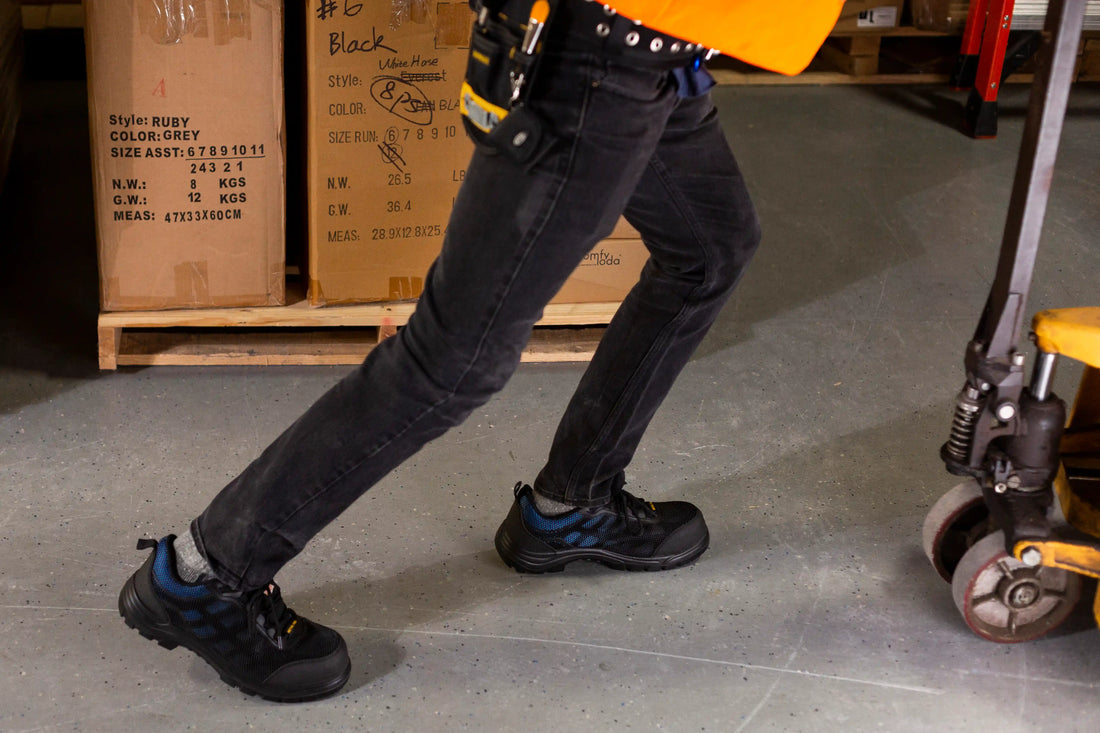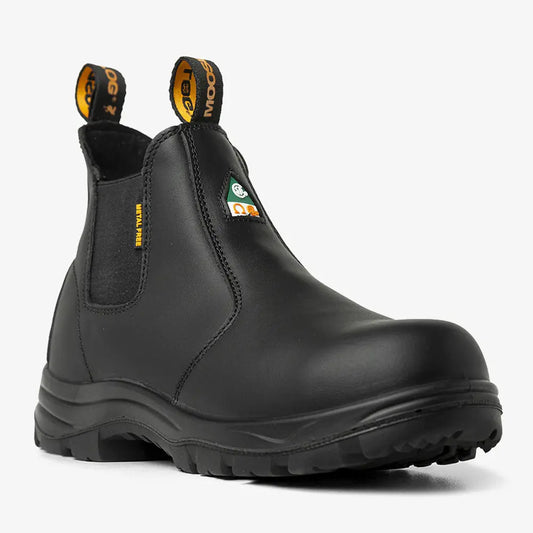
Breaking Down ASTM F2413: What Every Worker Should Actually Know
ASTM F2413 is the gold standard when it comes to safety footwear in North America. If you’ve ever shopped for work boots, you’ve likely seen labels like “ASTM F2413-18” or “ASTM compliant boots.” But what does it actually mean? This guide breaks down the essentials: how the standard works, what protections it covers, and why it matters if you’re in construction, warehousing, utilities, manufacturing, or any environment that demands certified protection.
What is ASTM F2413?
ASTM F2413 is a safety standard developed by ASTM International that sets performance requirements for protective footwear. The standard ensures work boots and safety shoes meet strict criteria for:
- Impact resistance (toe protection against falling objects).
- Compression resistance (preventing crushing injuries).
- Metatarsal protection (shielding the upper foot).
- Conductive (Cd), Static Dissipative (SD), and Electrical Hazard (EH) ratings.
- Puncture resistance (protecting against nails or sharp objects underfoot).
When a boot is labeled ASTM F2413, it means it has been lab-tested and certified to meet or exceed these safety requirements.
ASTM F2413-18 vs. Earlier Versions
You may see “ASTM F2413-18” specifically. That “18” refers to the year of the latest update (2018). Every few years, ASTM revises the standard to account for:
- New technologies in footwear materials.
- Updated testing methods.
- Alignment with workplace safety needs.
ASTM F2413-18 is the current version, so always check that your boots are certified to the latest update rather than an older edition.
Decoding the ASTM Label
Most ASTM-certified boots will have a tag or imprint inside the tongue or collar that looks something like this:
ASTM F2413-18 M I/75 C/75 EH
Here’s what it means:
- M = Male (F for Female).
- I/75 = Impact resistance up to 75 ft-lbs.
- C/75 = Compression resistance up to 2,500 lbs.
- EH = Electrical Hazard protection.
Depending on the boot, you may also see:
- PR = Puncture Resistant.
- Mt = Metatarsal protection.
- SD = Static Dissipative.
- Cd = Conductive.
Learning to read this label is the fastest way to know if boots meet your job’s requirements.

Why ASTM F2413 Matters on the Jobsite
Every workplace hazard is different. That’s why ASTM divides protection levels into clear categories:
- Construction sites: Impact and compression resistance are non-negotiable.
- Warehousing and logistics: Slip resistance, puncture protection, and EH matter most.
- Electrical work: EH or SD ratings help reduce risk of shock.
- Heavy manufacturing: Metatarsal and puncture resistance add crucial coverage.
Wearing uncertified boots can leave workers vulnerable — and employers non-compliant with safety regulations.
ASTM vs. CSA: Key Differences
In Canada, workers often see CSA Z195 listed instead of ASTM. While both are rigorous, here’s the difference:
- ASTM F2413 → U.S.-based standard, widely used across North America.
- CSA Z195 → Canadian equivalent, includes some additional testing, especially around sole puncture resistance and electrical performance.
Many premium boots today are dual-certified to both ASTM and CSA, ensuring they meet safety requirements across borders.
For a deeper dive into how these two standards compare, check out our blog: CSA vs ASTM: Which Safety Boot Certification Do You Need?
Common Misconceptions About ASTM F2413
- My boots are steel toe, so they must be ASTM. → Not true. Toe protection is just one element; ASTM covers multiple categories.
- Composite toe boots aren’t as safe. → False. Composite toes can pass the exact same I/75 and C/75 tests as steel.
- Lightweight boots can’t be ASTM compliant. → Wrong. Advances in composites, nano toes, and high-rebound insoles make lightweight ASTM boots possible.
How to Choose the Right ASTM Certified Boot
When shopping, look beyond just the “ASTM F2413” stamp. Ask:
- Do you need EH or SD protection for electrical work?
- Is puncture resistance required for your trade?
- Will a metatarsal guard be mandatory?
- Do you prefer composite, steel, or alloy toe options?
Matching the boot’s ASTM code to your work environment ensures safety compliance and comfort.
The Future of ASTM Footwear
Expect to see even more innovation: lighter composites, slip-resistant compounds, eco-certified leathers, and breathable waterproof membranes — all while maintaining ASTM F2413 standards. Footwear manufacturers are investing in lab testing to prove safety without adding unnecessary bulk.
Conclusion
Between your toes and a cinder block is the shield: ASTM F2413. It’s the standard that decides whether your boots can take the hit when weight, voltage, and hazards show up on the job.
Either your boots are certified, or you’re leaving your safety strategy up to chance. Ask yourself: do these meet ASTM F2413, or am I relying on luck as my safety strategy? So before you step onto concrete, steel, or gravel, check the tag.
At MooseLog, every boot is dual-certified to ASTM F2413 and CSA Z195, lab-tested for impact, puncture, and electrical hazard protection, and designed with modern materials that balance safety with wearability. Whether you buy from MooseLog or another trusted brand, the takeaway is simple: always check for ASTM F2413 certification before stepping onto the jobsite.






